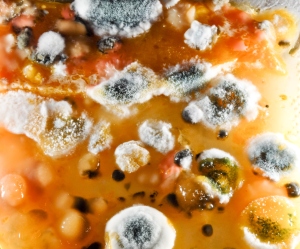
MOLD colonization occurs when MOLD spores and moisture find one another on surfaces that they consider food, such as wood, paper, leather, cloth, dusty and dirty surface conditions and more. Molds will often grow in damp or wet areas indoors. If the moisture source is not identified and stopped, the MOLD colonization will advance, and begin to release new MOLD spores into the air in amplified proportions.
How do you know if you have a mold problem?
A few signs to look for:
Mold can be found almost anywhere in the home environment. It appears most often in moist or wet areas. A musty odor may also be present. Mold begins to grow indoors when mold spores land on surfaces that are wet or damp. Mold won’t grow without moisture or water. Therefore, it is important to dry out wet or moist areas within 24 to 48 hours to prevent mold growth.
Some examples of places where mold can be found are:
Basements, kitchens (bottom of fridge or under the sink), around bathroom vanities, under walls paper, washer/dryer area, and bathrooms. Before fungi can colonize, four requirements must be met: moisture, air, slightly humid or livable temperature and food. Humidity and water leaks are the leading common cause of most mold infestations. Leaks being the easiest to spot are the first indications that mold may be present, however unusual activities may upset the humidity averages in the house and mechanical spaces and allow mold to establish itself.
By sending a sample of the biological growth to a lab, they will be able to determine whether it is mold, and what species of mold. They would need to use a surface sampling technique that allowed the species to be identified. and in some cases air sampling will also be required
What are the potential health effects of mold in homes?
Mold exposure does not always present a health problem indoors. However some people are sensitive to molds in which they can become susceptable to health risks.These people may experience symptoms such as nasal stuffiness, eye irritation, wheezing, or skin
irritation when exposed to molds. Some people may have more severe reactions to molds. Severe reactions may include fever and shortness of breath. Immune compromised persons and persons with chronic lung diseases like COPD are at increased risk for opportunistic infections and may develop fungal infections in their lungs.
Some individuals with underlying health conditions may be more sensitive to molds.
For example, individuals who have other allergies or existing respiratory conditions such as asthma, sinusitis, or other lung diseases may be more easily affected. Similarly, persons who have a weakened immune system tend to be more sensitive to molds.
What type of mold am I dealing with?
Allergenic molds are normally not dangerous in low amounts, but they can cause allergenic or asthmatic symptoms such as wheezing or runny nose. These molds can be abated safely with the assistance of gloves and a disposable particulate-removing respirator.
Mycotoxic molds can cause serious health effects in humans and animals. Health effects range from short-term irritation to immune suppression to cancer and even death. If any toxic molds are identified, it is suggested that you seek advice from an Industrial Hygienist or other mold professional for guidance. The average homeowner should NOT attempt the abatement of these types of mold.
Pathogenic molds can cause serious health effects in persons with suppressed immune systems, those taking chemotherapy, those with HIV/AIDS, or autoimmunity disorders. If any pathogenic molds are identified, it is suggested you seed the advice of an Industrial Hygienist or other mold professional for guidance. The average homeowner should NOT attempt the abatement of these types of mold.
Hyphae & hyphal elements refer to single, unidentifiable fragments of mold. Although they may not be traceable to a specific mold species, the fragments themselves may be responsible for allergic reactions in some people and may indicate previous or current growth event. Smut spores are agricultural spores from outside sources.
Ascospores and basidiospores are clusters of spores that may not be easily identified as per specific species, but may still represent f mold problem in the home.
What are the first steps you should do in the event of Water Damage / Flood?
Identify the source of the incoming water and, if possible, stop it or call a professional to handle it.
Turn off all electrical appliances in and around the area affected by water before you get in to the area to
reduce electrical hazards.
Remove or elevate furniture off wet areas to prevent permanent stains or rust marks from occurring.
Empty out closet floors, including shoes and cardboard boxes which could cause staining.
Call Water Damage Zone today (877) 520-1923 your future bills may be a lot smaller, if you follow these simple tips. You can also visit our sister company for further information on restoration services at Best American Builders.
We specialize in the following services:
- 24/7 Emergency Response, Water Extraction, Water Damage
- Direct Billing to Insurance, Locally Owned and Operated
- Water Cleanup, Water Dry outs, Visual Mold Inspections, Sewage Damage Cleanup
- Sterilizing & Odor Removal, Licensed & Bonded #963976, Reputable Los Angeles based company
- Image from depositphotos, ID 15892692
- Shutterstock Sequence Number: US-041C159DA-1
Corporate Office
15115 Califa St. Ste. C
Van Nuys, CA 91411
Great article. Really help me understanding more about mold
LikeLike